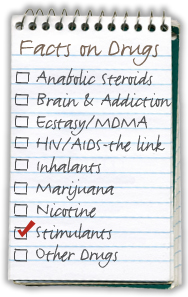Stimulants are a class of drugs that elevate mood, increase feelings of well-being, and increase energy and alertness.
Stimulants often produce a feeling of euphoria in users. Examples of stimulants include cocaine, crack cocaine, amphetamines, Methamphetamine, methylphenidate (Ritalin®), nicotine, and MDMA (3-4 methylenedioxyMethamphetamine, better known as Ecstasy).
Cocaine is a hydrochloride salt, made from the leaf of the coca plant, and comes in the form of a white powder. [1] Crack is a smokeable form of cocaine that is processed with ammonia or baking soda and water, and heated to remove the hydrochloride. [2]
Amphetamines are sometimes prescribed by doctors for medical problems, but these pills are also abused for their effects on the brain. Methamphetamine is a powerful form of amphetamines that comes in clear crystals or powder and easily dissolves in water or alcohol. It is often made in illegal laboratories with inexpensive and readily available ingredients (such as drain cleaner, battery acid, and antifreeze). [1] [3] [4]
Methylphenidate (Ritalin®) is a medication prescribed for individuals (usually children) with attention-deficit hyperactivity disorder (ADHD). Numerous studies have shown its effectiveness, when used as prescribed, in the treatment of ADHD. When it is abused or not used as prescribed, however, methylphenidate can lead to many of the same problems seen with other stimulants. [5]
Nicotine and MDMA also are considered stimulants and are covered in separate topics on this Web site.
Cocaine is generally sold on the street as a fine, white, crystalline powder, known as "coke," "C," "snow," "flake," "blow," "bump," "candy," "Charlie," "rock," and "toot." [2] [6] "Crack," the street name for the smokeable form of cocaine, got its name from the crackling sound made when it's smoked. [2] A "speedball" is cocaine or crack combined with heroin or crack and heroin smoked together.
Street names for amphetamines include "speed," "bennies," "black beauties," "crosses," "hearts," "LA turnaround," "truck drivers," and "uppers." [6]
Methamphetamine is commonly known as "speed," "meth," "chalk, and "tina." In its smokable form, it's often called "ice," "crystal," "crank," "glass," "fire," and "go fast." [4] [6]
Street names for methylphenidate include "rits," "vitamin R," and "west coast." [7]
Stimulants can be taken in several ways:
Compared to stimulants that are swallowed or snorted, those that are injected or smoked are absorbed into the bloodstream more quickly, intensifying the effects of the drug. It is also important to note that sometimes these drugs are diluted with other toxic substances.
Cocaine is snorted or injected (called "mainlining"), or it can be rubbed onto mucous tissues, such as the gums. Street dealers generally dilute cocaine with other substances (such as cornstarch, talcum powder, or sugar); with active drugs (such as procaine, a chemical that produces local anesthesia); or with other stimulants (such as amphetamines). Crack cocaine is smoked in a glass pipe. [2]
Amphetamines are usually swallowed in pill form. Methamphetamine is swallowed, snorted, injected, or smoked. "Ice," a smokeable form of Methamphetamine, is a large, usually clear crystal of high purity that is smoked, like crack, in a glass pipe. [4]
A 2004 NIDA-funded study reported that the following percentages of 8th-, 10th-, and 12th-graders had tried these drugs at least once: [8]
Twelfth-graders regularly reported the highest rate of use for all three drugs. Conversely, eighth-graders reported a drop in use for all three drugs, with a significant drop in Methamphetamine use, from 3.9 percent in 2003 to 2.5 percent in 2004. [8]
[Back to top]